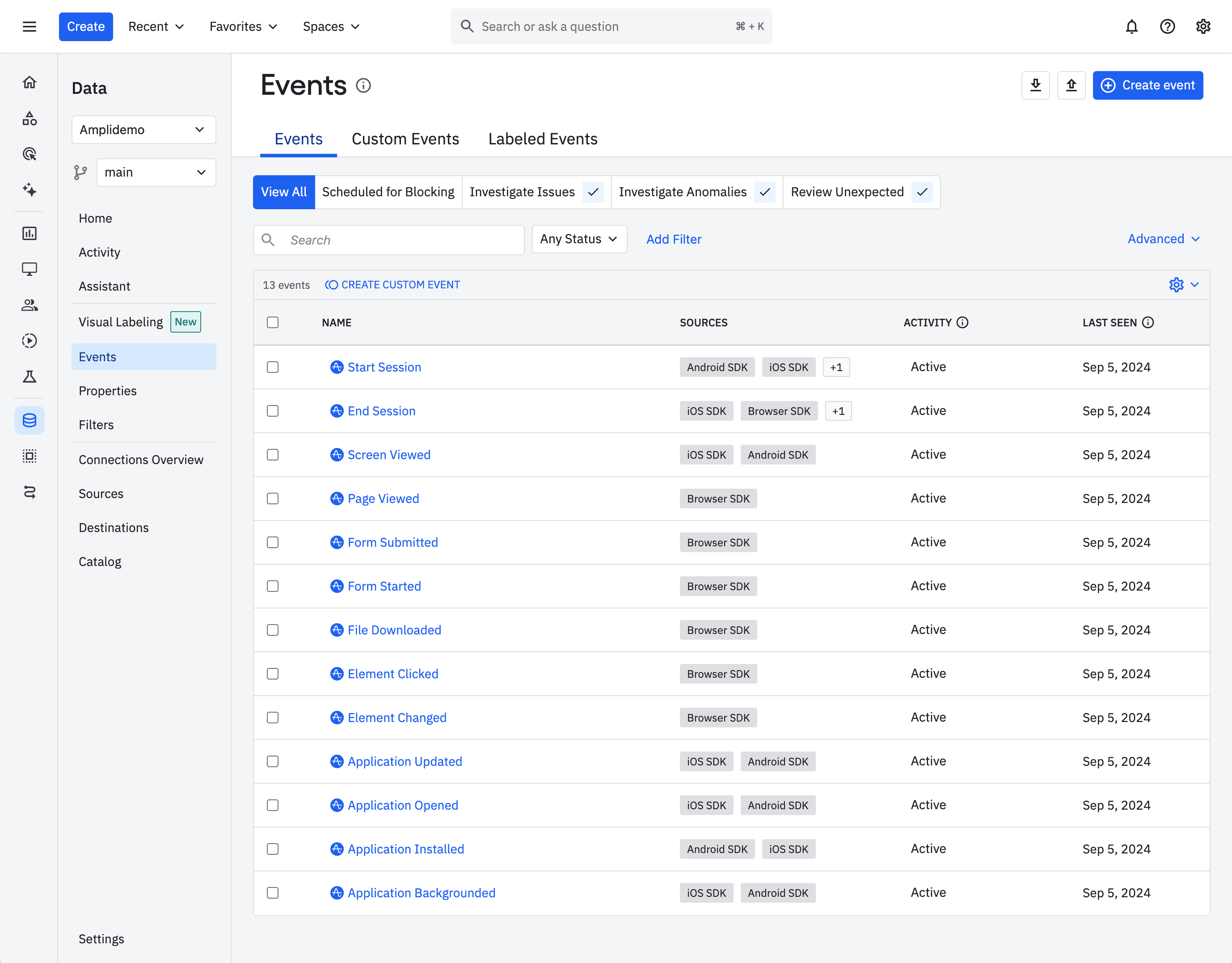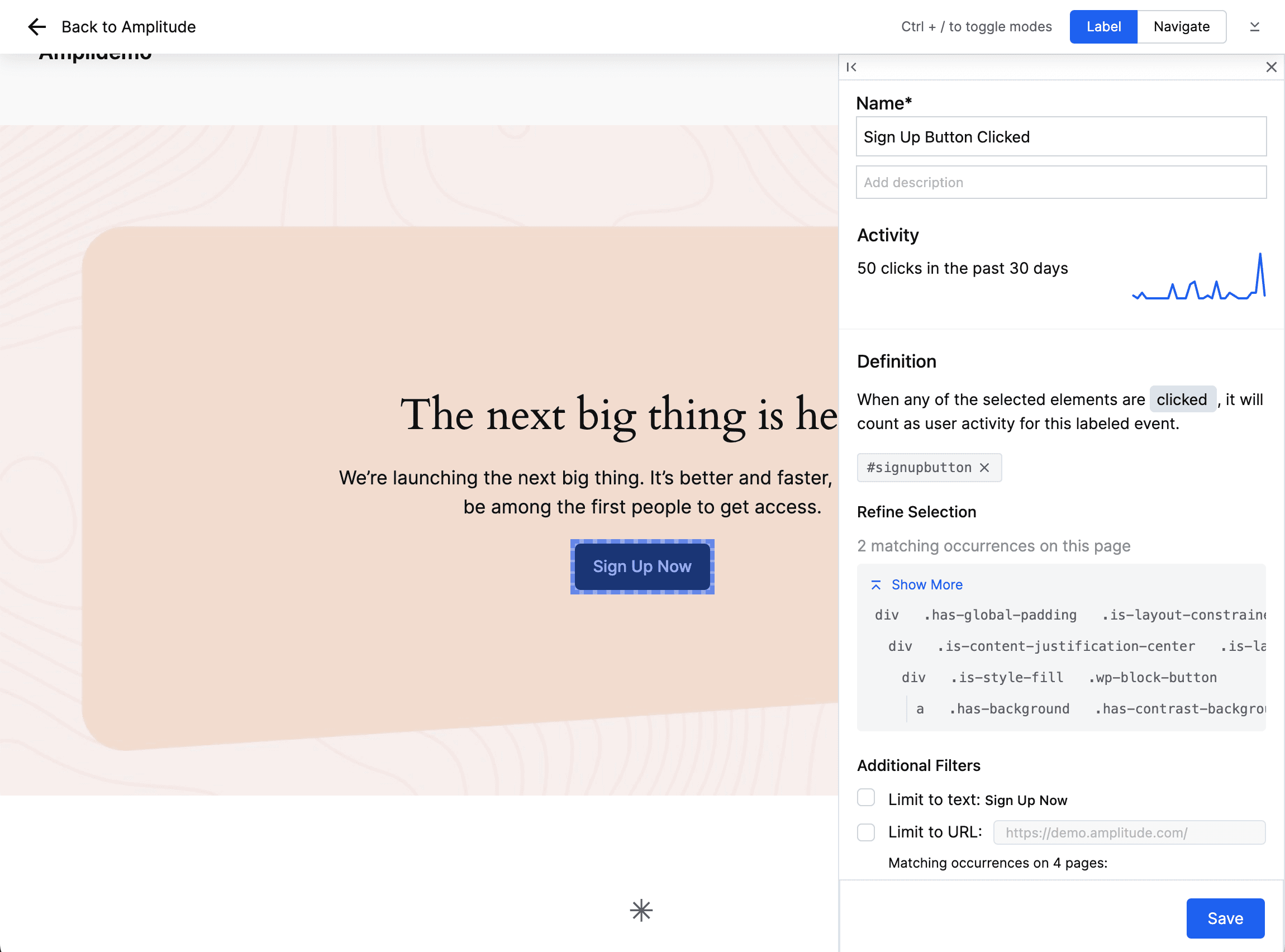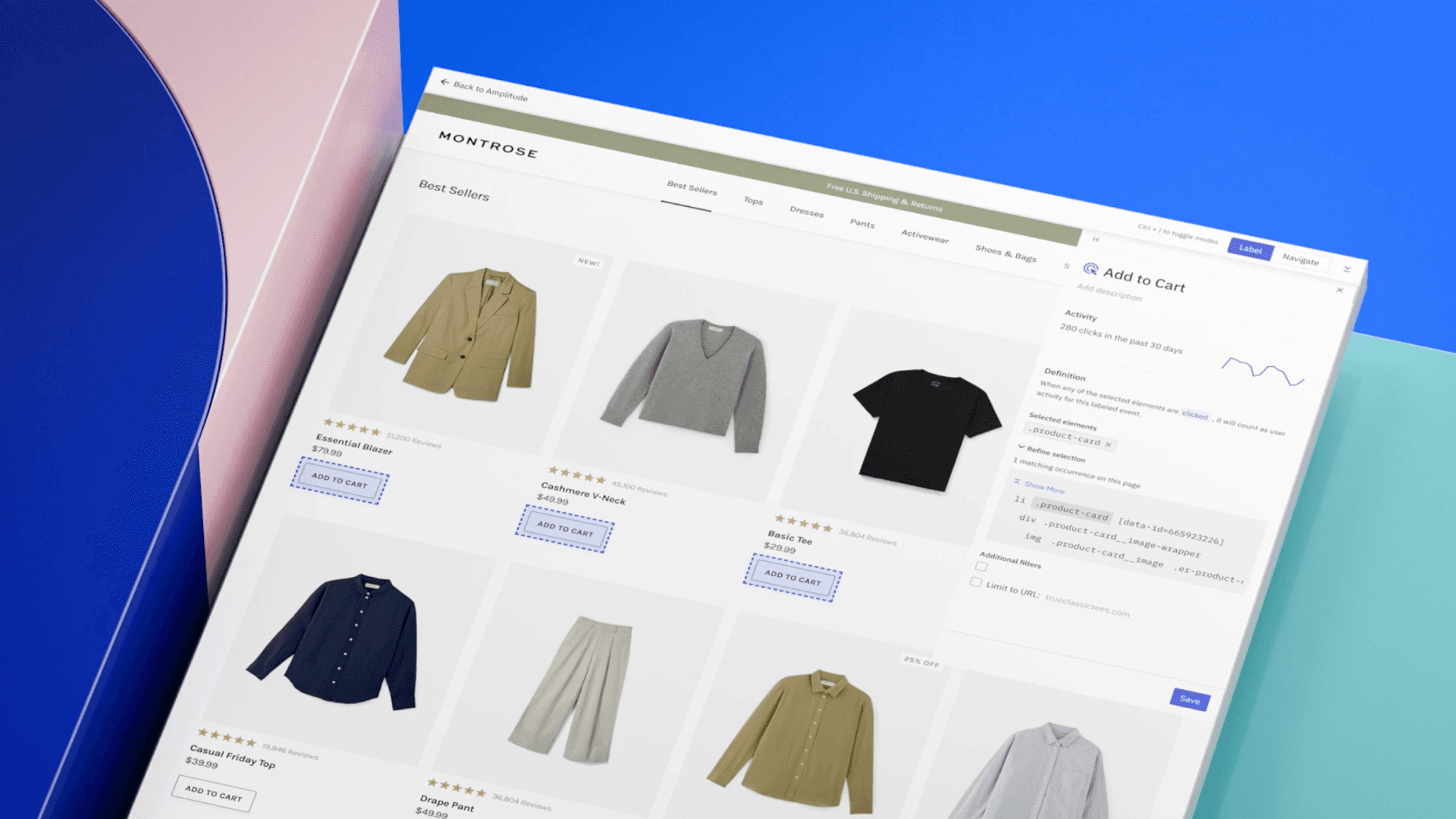Unlock Insights Faster with Autocapture
Event tracking, simplified: No code, no problem.
Getting started with analytics can require a lot of expertise. Traditionally, getting set up has required product or growth teams to work with engineering to instrument tracking code for every single event, leading to a backlog that prevents many teams from getting the insights they need quickly.
Autocapture, or auto-track, technologies provide a solution for this. They automatically capture clicks, views, and other user interactions, with minimal engineering required.
Here’s why you’ll love Autocapture
Organized data from the start
With precisely tracked events, you typically define the events and properties to track, work with an engineer to implement them, and verify that they are working as expected. Autocapture follows these same best practices, except we've done most of that work for you.

Predefined events available with Autocapture
We’ve designed Autocapture with predefined events and property types based on the most common types used by our customers. This way, the ingestion is predictable, and your taxonomy stays clean.
With Autocapture, we offer a number of defined events and properties available out of the box:
- Default event tracking on Web, iOS, and Android, which captures sessions, page views, form interactions, app installs and upgrades, and other events out of the box.
- Amplitude properties, which capture things like user location, device, platform, carrier, etc.
- Marketing attribution on the web, which captures attributes like UTM parameters, click IDs, and referrers.
- Pre-defined interaction events—“Element Clicked” and “Element Changed”—that capture important interactions across your app or website.
You’ll see these predefined events reflected in your taxonomy with an Amplitude logo. We’re also introducing a new tool called “visual labeling,” which enables you to label these specific types of interactions for further analysis.
Define important interactions with visual labeling
With Autocapture enabled, non-engineers can quickly create events using visual labeling and retroactively analyze the data they need. For example, if you launched a new landing page and wanted to see how many people clicked the sign-up button at the top, you can create an event and analyze the data from the date the page launched.

Track events you need with visual labeling
One drawback of these “labeled” events is that they haven’t been directly integrated with your code. Depending on how your app is built, a code change could potentially break the event tracking. The good news is that anyone can fix the event by updating the definition. But events breaking can erode trust in your data.
To help with this problem, we’ve organized visually labeled events to make it easier to manage:
- Visually labeled events use a different icon to provide transparency on how they were created.
- We’ve separated these into their own “Labeled Events” tab in Amplitude Data so you can manage them separately.

Maintain labeled events separately in Amplitude.
You'll still have all the robust precision tracking workflows and data management while adding new visual labeling tools. Transparency with analytics users and organized management tools for data owners help maintain trust. We’re continuing to evolve this experience with more data management capabilities and workflows to keep your labeled events organized and maintained.
Strong security and privacy considerations
We believe that giving you flexibility and control over what you collect is another crucial part of ensuring that your data is predictable and manageable.
For many organizations, data privacy, security, and PII are critical factors in their data collection strategy. Business needs and data privacy requirements between jurisdictions can vary greatly, which means a one-size-fits-all approach doesn’t work.
Autocapture’s default settings are designed to enable you to adhere to your privacy and security requirements. Autocapture will not capture end-user inputs and has safeguards in place to help you exclude certain sensitive information that may appear on your page. In addition, we give you the ability to turn specific Autocapture events on and off and the flexibility to capture clicks only on particular element types or pages. These options help to ensure you can continue to meet your compliance needs.
With Amplitude, you remain in control of what information is sent to help ensure the security and protection of your data.
Additional flexibility and control for event volume
We’ve also added controls that help you manage your event volume and cost. For example, by default, we only capture clicks on interactable elements—like links, text fields, dropdowns, and changes to a page. We automatically exclude interactions that don’t have value to drive down costs, like blank areas or dead clicks. You can configure this to limit click tracking to even fewer elements or capture even more clicks as needed.
Autocapture and the full value of a digital analytics platform

One line of code unlocks the unified Amplitude platform.
One of the most exciting aspects of Autocapture is that it’s implemented with one line of code. This also unlocks the full power of Amplitude, including Analytics, Session Replay, CDP, and Experimentation. This means you can access both quantitative and qualitative data that helps you better discover why users behave the way they do and iterate and improve their experiences quickly. This combination of insights makes it even easier to convert insights into actions and improve your customers’ digital experiences. All of this can now be unlocked with one line of code.
Even with limited engineering capacity, you can get started quickly and unlock new insights about your customers’ journeys through your digital product experience.
Follow these steps to set up Autocapture in approximately 30 minutes
1. Ensure you have the latest version of the Amplitude SDK
You won’t be able to activate Autocapture unless you have Amplitude’s latest SDK. Autocapture capabilities are included in the latest SDK by default.
Unsure which SDK version you’re using? Refer to this help doc. Follow these instructions to upgrade your Amplitude SDK version:
- Autocapture for the web (including npm, yarn)
- Autocapture for iOS
- Autocapture for Android
2. Confirm that Autocapture is enabled correctly
To confirm Autocapture is activated, we recommended running some pre-checks. Simply follow the instructions outlined in this Academy Video.
3. Set your team up for success!
Once you have successfully enabled Autocapture, all users with member permissions or above can self-serve Autocapture capabilities.
To ensure Autocapture best practices, check out this Amplitude Academy video. Additional support can be found in this Autocapture help doc.
We’ve changed our tune—FAQ to our new approach
We purposefully didn’t build auto-tracking at the onset. And in 2020, we wrote a blog addressing why. But we’re on a mission to make analytics effortless, and part of that is making it easy for teams to get started on their analytics journey. That’s why we’ve changed our stance on Autocapture.
Below, we’ll address some of the most commonly asked questions about our approach and change of heart.
You previously claimed that Auto-tracking doesn’t eliminate work; it shifts work to a less scalable process. Is this still true?
Though we’ve always championed the benefits of precisely tracked events, we recognize the need to reduce the workload on engineering teams. Some companies just don't have the engineering resources to own and maintain their analytics implementations.
For teams with an analyst, PM, or marketer looking to get basic insights quickly without the dedicated support of an engineering team, we’re working to make capturing those insights even easier. Our SDK empowers you to get data like session information, page views, user platforms, device types, locations, and marketing attribution right out of the box.
Additionally with visual labeling, teams can now identify specific types of interactions for further insights. All of this can help ramp up analytics implementations.
Does auto-tracking miss the full story of what’s happening in your product?
To get deep insights from your data, the best approach is to instrument events with a rich set of properties that help answer “why” customers are doing what they are doing. But companies getting started on their analytics journey might not know what specific questions to ask about their data.
For these customers, instead of coming up with a tracking plan to figure out what questions to ask, Autocapture can help identify those questions and future opportunities for precision tracking. By providing a baseline set of metrics, we give you visibility quickly out of the box so you can uncover the deeper questions that can inform your longer-term tracking needs. You’ll be better informed about what questions you want to ask versus trying to identify them at the outset.
The other benefit of this approach is that even if you have an established tracking plan, you may be missing critical information. With Autocapture, you get a baseline set of events that can help fill in some gaps regarding this missing information.
Can auto-tracking break–creating more work, false assumptions, and data distrust? Should I be concerned with data quality?
The short answer is that it can. However, we approach the problem differently than other vendors to tackle these concerns head-on.
First, we’re tracking raw events in a structured way that won’t pollute your tracking plan. For click interactions, we only add two new events to your schema for visual labeling: Element Clicked and Element Changed.
Second, we’re very intentional about the types of clicks we capture. By default, we focus on clicks that lead to an action on your site, such as links and form elements. Conversely, we ignore clicks on blank spaces. Labeled events are also separated in our data schema from our precision-tracked events and identified in analysis with a different icon.
In some cases, depending on your site architecture, you may want to consider limiting Autocapture to some of the default events and properties available via our SDK while opting for precision tracking for click-based interactions when your pages have unstable classes or lack unique element identifiers. Learn more about site considerations here.
How has Amplitude designed Autocapture with security and privacy in mind
First and foremost, Amplitude is concerned about the security and privacy of our customer’s data. That’s why we have developed industry best practices for implementation and platform capabilities that ensure our customers ingest clean, actionable event data—exactly as intended.
Additionally, we’ve investigated many of the issues around auto-track that have caused security incidents in the past, learned from them, and adopted best practices for our customers.
By default, we offer a very conservative approach to the types of elements that you can collect with Autocapture. Our default settings do not capture any end-user text or inputs, and we automatically exclude any text on your pages that looks like a credit card or social security number. We also provide the ability for you to refine what you collect and where you deploy Autocapture, which we especially recommend you utilize on pages that may contain sensitive data, such as financial or medical information. Specifically, you can limit click tracking on the list of elements that Autocapture can track or even restrict the types of pages allowed for click and change tracking. Finally, Autocapture is an option, not a requirement, when using Amplitude. You can opt to completely turn off any or all Autocapture events through your SDK configuration.
At the end of the day, you are in control of what information Autocapture sends to Amplitude. We’ve designed the SDK with flexible configuration options to enable you to continue to adhere to your company’s legal and security requirements.

Jeffrey Wang
Co-founder & Former Chief Architect, Amplitude
Jeffrey originated the infrastructure that enables us to scan billions of events every second at Amplitude. He studied Computer Science at Stanford and brings experience building infrastructure from Palantir and Sumo Logic.
More from Jeffrey




